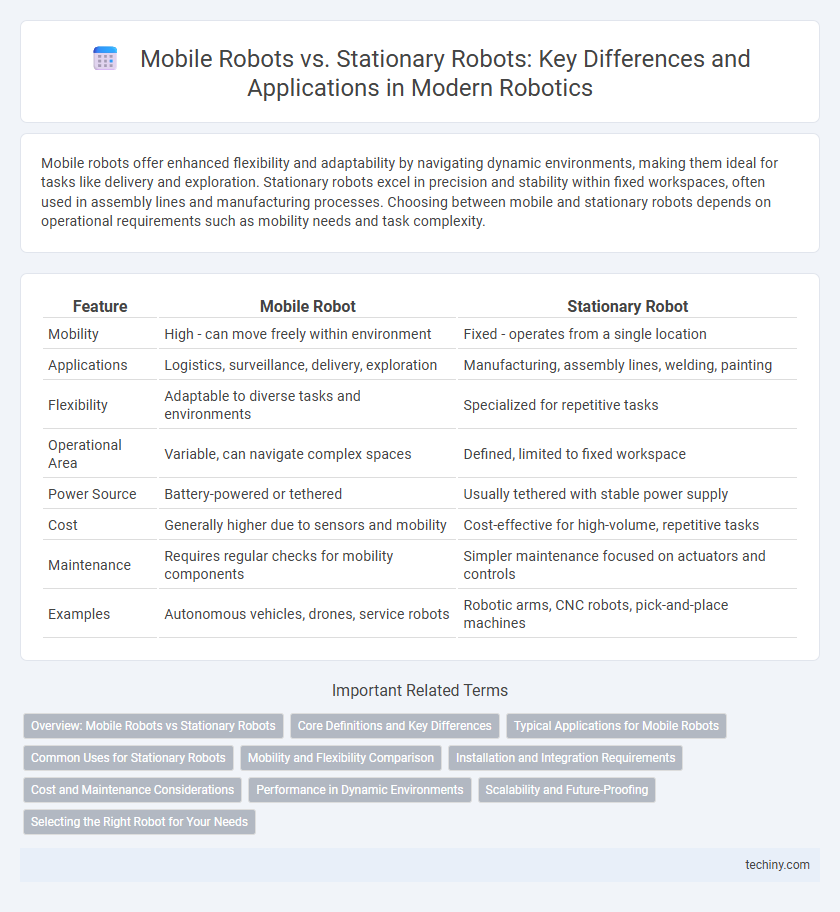Mobile robots offer enhanced flexibility and adaptability by navigating dynamic environments, making them ideal for tasks like delivery and exploration. Stationary robots excel in precision and stability within fixed workspaces, often used in assembly lines and manufacturing processes. Choosing between mobile and stationary robots depends on operational requirements such as mobility needs and task complexity.
Table of Comparison
| Feature | Mobile Robot | Stationary Robot |
|---|---|---|
| Mobility | High - can move freely within environment | Fixed - operates from a single location |
| Applications | Logistics, surveillance, delivery, exploration | Manufacturing, assembly lines, welding, painting |
| Flexibility | Adaptable to diverse tasks and environments | Specialized for repetitive tasks |
| Operational Area | Variable, can navigate complex spaces | Defined, limited to fixed workspace |
| Power Source | Battery-powered or tethered | Usually tethered with stable power supply |
| Cost | Generally higher due to sensors and mobility | Cost-effective for high-volume, repetitive tasks |
| Maintenance | Requires regular checks for mobility components | Simpler maintenance focused on actuators and controls |
| Examples | Autonomous vehicles, drones, service robots | Robotic arms, CNC robots, pick-and-place machines |
Overview: Mobile Robots vs Stationary Robots
Mobile robots offer dynamic navigation and adaptability, enabling tasks in diverse and changing environments through sensors and autonomous control systems. Stationary robots excel in precision and repetitive tasks within fixed workspaces, often used in manufacturing and assembly lines for consistent performance. The choice depends on application requirements, where mobility enhances flexibility while stationary designs prioritize stability and accuracy.
Core Definitions and Key Differences
Mobile robots are autonomous machines capable of navigating and performing tasks in various environments, equipped with sensors and locomotion systems, while stationary robots remain fixed in one location, typically used for repetitive industrial tasks. Key differences include mobility, with mobile robots offering flexibility and adaptability in dynamic settings, whereas stationary robots provide high precision and stability in controlled environments. Mobile robots often rely on complex navigation algorithms and obstacle detection, contrasting with stationary robots that emphasize repeatability and payload capacity.
Typical Applications for Mobile Robots
Mobile robots are extensively utilized in logistics and warehouse automation to transport goods efficiently across dynamic environments. They excel in inspection and surveillance tasks in large industrial facilities, providing real-time data collection without human intervention. Autonomous delivery robots also serve last-mile delivery in urban settings, enhancing operational flexibility and reducing labor costs.
Common Uses for Stationary Robots
Stationary robots are predominantly used in industrial manufacturing environments for tasks such as welding, painting, assembly, and material handling, where precision and repeatability are critical. These robots excel in high-volume production lines, improving efficiency and consistency in automotive, electronics, and packaging industries. Their fixed position allows for integration with conveyor systems and heavy-duty tools, enabling complex operations in controlled settings.
Mobility and Flexibility Comparison
Mobile robots offer superior mobility, enabling autonomous movement across diverse environments without the constraints of a fixed location. Stationary robots, while limited in physical movement, provide high precision and stability, making them ideal for repetitive tasks in controlled settings. The flexibility of mobile robots allows dynamic task execution and adaptability, whereas stationary robots excel in specialized operations requiring consistent positioning.
Installation and Integration Requirements
Mobile robots require flexible installation procedures with emphasis on wireless connectivity, battery management systems, and adaptable integration with dynamic environments, enabling seamless navigation and task execution. Stationary robots demand precise positioning, robust mounting structures, and reliable wired power sources to ensure stability and consistent operation within fixed workspaces. Integration of mobile robots involves complex sensor fusion and environment mapping technologies, while stationary robots focus on streamlined integration with existing assembly lines and automation control systems.
Cost and Maintenance Considerations
Mobile robots generally incur higher costs due to their complex locomotion systems and the need for advanced sensors and navigation hardware, leading to increased initial investment and ongoing maintenance expenses. Stationary robots, fixed in one location, often have lower maintenance demands and longer lifespans because they operate in controlled environments with fewer mechanical wear points. Choosing between mobile and stationary robots requires a cost-benefit analysis that weighs mobility advantages against maintenance frequency and total cost of ownership.
Performance in Dynamic Environments
Mobile robots exhibit superior adaptability and flexibility in dynamic environments due to their ability to navigate changing terrains and avoid obstacles in real-time. Stationary robots, while highly precise and efficient in repetitive tasks, lack the mobility required to respond to environmental variations and disruptions. Performance in dynamic settings heavily favors mobile robots because of their integrated sensors and autonomous decision-making capabilities, enabling continuous operation amid uncertainties.
Scalability and Future-Proofing
Mobile robots offer superior scalability with their ability to adapt to varied environments and tasks, enabling easy integration of new modules and software upgrades. Stationary robots, while highly specialized for fixed operations, face limitations in scalability due to their rigid setup and dependence on specific infrastructure. Future-proofing is more feasible for mobile robots as they support continuous innovation in navigation, sensing, and AI, ensuring adaptability to evolving industrial demands.
Selecting the Right Robot for Your Needs
Selecting the right robot depends on the specific tasks and environment; mobile robots offer flexibility for dynamic, large-scale operations requiring navigation and adaptability, while stationary robots excel in repetitive, high-precision tasks within controlled settings. Factors such as payload capacity, workspace constraints, and integration with existing systems influence the decision between mobile and stationary options. Assessing operational requirements, maintenance capabilities, and cost-effectiveness ensures optimal robot deployment tailored to productivity goals.
Mobile robot vs Stationary robot Infographic

 techiny.com
techiny.com